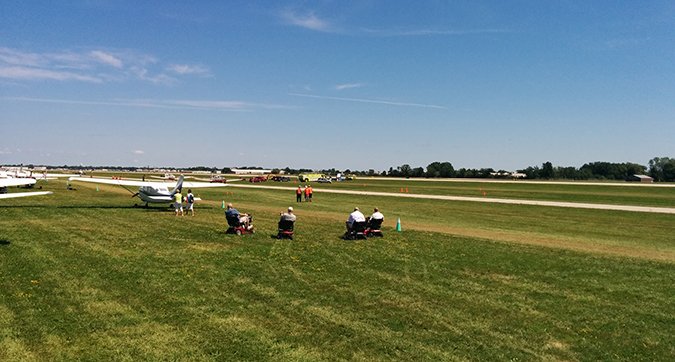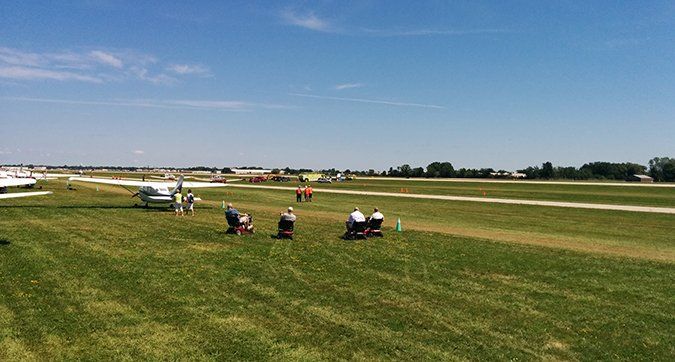There I was, on my last day at EAA’s 2016 AirVenture extravaganza in Oshkosh, Wis. It had been a great week, with a full Oshkosh “experience,” including camping in the rain, spending some money and catching up with old friends. The airplane was loaded and preflighted, the door was closed and I was strapped in. I’d gotten the departure flick from the ATIS and from watching airplanes depart Runway 36L, the threshold for which was about 200 yards east and south of me. I was ready to power things back up, start the engine and get outta Dodge.

And I was lucky: with the surface wind out of the east, the airport was using the adjacent runway for departures. I wouldn’t have to taxi to Green Bay before I could take off. I had filed for an IFR clearance from over Muskegon, Mich., and actually appeared to be a bit ahead of schedule to pick it up for once. The weather was good VFR across Lake Michigan, with typical summer airmass thunderstorms pretty much the rest of the way to my destination.
As I looked up to clear the area in front of the airplane before starting the engine, my attention was drawn to a blue and white taildragger that looked like a Citabria. It was right over the runway, about 250-300 yards away and 50 or so feet agl. It was mostly unremarkable. The peculiar thing, though, was that it wasn’t moving.
It seemed to stay motionless for a second or two. Then it stalled, breaking left into the beginnings of a spin. In the short time before it hit the ground, it rotated through about 180 degrees of the left spin. It seemed to hit hard, bounce, rotate a bit more, then come to rest more or less pointing slightly east of south—call it 150 degrees.
“That’s something you don’t see every day,” literally was the first considered thought through my mind. The next was, “Wait…an airplane just crashed in front of me. What should I do?” So far, there was no fire, but all I had was a puny Halon bottle strapped down behind my seat. About that time, a flagman ran past my parking row toward the scene, and it appeared others closer than him were responding. Maybe 20 seconds later, an airport crash truck appeared, followed by an ambulance and other vehicles. The image on page 2 was taken maybe five minutes afterward.
Aftermath
The airport closed. Several airplanes had been on the taxiway adjacent to 36L when the event occurred. Their pilots stopped where they were and shut down while responders did their jobs. After maybe 20 minutes, the airport re-opened, although 36L remained closed, and I was clear to start my engine. It took a solid 30 minutes of sharing the taxiways with 50 of my closest friends before I was #1 for Runway 9, the only one in operation. After stopping for fuel and a snack outside Cheap Avgas, Ind., I motored on home, arriving after sundown without further drama.
Of course, that wasn’t the end of it for me. For one, that taildragger seemed to hit pretty hard. I was close enough to see the whole thing, but not close enough to determine if anyone had gotten out of it, or even how many were aboard. I was sure the airplane wouldn’t be flying again anytime soon, as at least its right main landing gear, along with the right wing, had collapsed. The engine likely had been damaged. I just hoped whomever was aboard was okay.
The night I got home and the next morning, I checked the Oshkosh-area news for any coverage. I didn’t find anything, but it was still the weekend, so there wouldn’t be anything on web sites run by the usual suspects. Later in the week, the event finally popped up on an FAA page devoted to daily tracking of aircraft accidents in the U.S. I was wrong about one thing: What I was certain had been a relatively new Citabria or Decathlon turned out to be a homebuilt Rans S-7S light sport aircraft.
The interesting news was the report simply stated the aircraft had exited the runway while attempting a takeoff, damaging its landing gear. That’s definitely not what I saw (which—along with confusion on aircraft types—initially led me to conclude this was an event other than what I had witnessed). The great news was there were no reported injuries.
I may or may not reach out the NTSB and offer myself as a witness. There are no great insights I can add, and nothing I might contribute is likely to be all that helpful at answering the question that’s been in my mind all along: What happened?
Immediately after the event, I would have said the airplane was landing and flared too high, entering a stall/spin from about 50 feet agl. Given an S-7’s performance, however, it’s entirely plausible the pilot had taken off and climbed 50 feet by the time I saw it about 500 feet beyond the Runway 36L threshold. Also, given the noise around me from other airplanes and activities, I never heard its engine. On the other hand, I never heard its engine, so it’s also plausible the engine quit about 50 feet agl and the pilot didn’t react quickly enough to prevent the ensuing stall.
It’s definitely outside my normal experience to witness an airplane accident. Spend enough time around airplanes, and I guess it’s inevitable.




